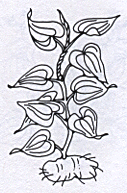Canoe Plants of Ancient Hawai`i Home - Intro - Contents - Bibliography - Links - Credits `Ape - `Awa -`Awapuhi -Hau -Ipu -Kalo -Kamani -Ki -Ko -Kou -Kukui -Mai`a Milo -Niu -Noni -`Ohe -`Ohi`a `Ai -`Olena -Olona -Pia -`Uala -Uhi -`Ulu -Wauke |
Canoe Plants of Ancient Hawai`i Home - Intro - Contents - Bibliography - Links - Credits `Ape - `Awa -`Awapuhi -Hau -Ipu -Kalo -Kamani -Ki -Ko -Kou -Kukui -Mai`a Milo -Niu -Noni -`Ohe -`Ohi`a `Ai -`Olena -Olona -Pia -`Uala -Uhi -`Ulu -Wauke |
 The common name for the edible Hawai`i yam is uhi. Uhi is also the specific name of Dioscorea alata, one of at least three yams brought to Hawai`i by migrating Polynesian peoples in their canoes. The other two yams brought here are Dioscorea pentaphylla or pi`a (not to be confused with pia, Polynesian arrowroot), and Dioscorea bulbifera, also called hoi (which is considered poisonous and should not be eaten, so it is curious that it is said to have been introduced here.) Most likely originating in tropical Asia and carried eastward into Polynesia, uhi is not to be confused with `uala, the sweet potato of Hawai`i.
The common name for the edible Hawai`i yam is uhi. Uhi is also the specific name of Dioscorea alata, one of at least three yams brought to Hawai`i by migrating Polynesian peoples in their canoes. The other two yams brought here are Dioscorea pentaphylla or pi`a (not to be confused with pia, Polynesian arrowroot), and Dioscorea bulbifera, also called hoi (which is considered poisonous and should not be eaten, so it is curious that it is said to have been introduced here.) Most likely originating in tropical Asia and carried eastward into Polynesia, uhi is not to be confused with `uala, the sweet potato of Hawai`i.The people of ancient Hawai`i usually ate the delicious starchy carbohydrate uhi after cooking it in an imu, underground oven, eating it while still warm, as it is said to be fit only for pigs when cold. It does not make good poi, because it is not sticky and is too mealy. Uhi never did become as popular here as a staple food, as it did in other Pacific societies, such as Tonga, for instance. Perhaps there was enough kalo, `uala and `ulu usually in season in Hawai`i. Uhi is a vine that grows for support on tree trunks and branches in moist forests and gulches. It is also grown upon stakes and other supports. The vine grows during summertime and withers away in the winter, while the large edible tubers continue to grow underground. New vine shoots appear at the beginning of the spring rainy season, which is the best time to dig up the yams to eat. It takes a full year's cycle to grow a crop. For food to be produced, the plants need a warm moist growing place with loose soil, and can be planted anytime of the year by propagation from pieces of the tuber, which will bear sprouts.
Heart-shaped ovate leaves 3-6 inches long grow wing-like on opposite sides of a square stem that has 4 flat sides and twines to the right. All yam leaves have veins that begin at the leaf base.
The flowers of uhi are small, with a yellow or yellow-green calyx and no petals. The edible fruit, tuber, of the yam forms after the female flower is fertilized. The tuber grows on an underground stem and is thick, variously shaped (lobed or elongated), depending on the variety. The tubers are also variously colored. Two of the varieties are ke`oke`o, which is white inside and outside, and `ula`ula, with red skin and white flesh. The `ula`ula was also used as medicine and is said to have healing properties useful for coughs, constipation, dysentery, appendicitis and for counteracting vomiting blood.
The uhi yam was the most widely cultivated and could be found growing along steep hillsides, where special cultivation methods were devised. The yam was also grown in bins, such as were built of tree-fern trunks on the big island of Hawai`i. In the post-Cook contact days, the yams of these islands were widely cultivated in fields, and were procured by the tons for shipboard use, where they were preferred to sweet potatoes which germinated more rapidly.
The pi`a yam differs from the uhi yam in that the vine stems are round, rather than square, and have no wings. The alternate palmate leaves are divided into 3-5 lobes, instead of being ovate, and there are small spherical or horse-shoe shaped aerial tubers scattered along the stem where the leaves connect. The underground tubers are bulbous, like turnips, or elongated, and are hairy with stiff rootlets. The tubers vary from brown to reddish or white inside. Pi`a are eaten cooked or warm, and are considered pig food when cold, like uhi.
The wild and very bitter poisonous yam called hoi can be recognized by its round stem and the round aerial tubers at the axils of the leaves (like the pi`a), but hoi has alternate heart-shaped leaves (like the uhi, but not winged like the uhi). The underground tubers are usually in pairs, with one larger than the other, shaped like fans or flattened spheres, reddish-brown on the outside and white inside. These should not be eaten as they are alkaloid and poisonous unless peeled and boiled and steeped in lime water for several days of changing the water frequently. The hoi yam is described here only for identification purposes, so that it may be avoided.
The moral of the story is, know your yams before you gather or cultivate them. Perhaps it is easy to see why we might prefer the ono, delicious, qualities of `uala/sweet potato, kalo/taro, and `ulu/breadfruit!
| Canoe Plants of Ancient Hawai`i Home Intro - Contents - Bibliography - Links - Credits `Ape -`Awa -`Awapuhi -Hau -Ipu -Kalo -Kamani -Ki -Ko -Kou -Kukui -Mai`a |